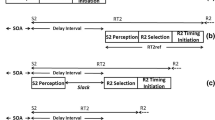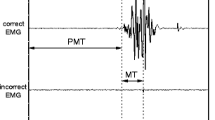Summary
A feature common to many studies investigating the relationship between reaction time (RT) and motor task demands is that, prior to responding, subjects have been able to preview the parameters of the movement they are required to make. This introduces the possibility of preprogramming the movement before entering the RT period, thus making it more difficult to detect a consistent relationship between RT and motor task demands. A “no-preview” condition (movement parameters concealed prior to the subject responding) was used in the present study to avoid this confusion. Reaction time was fractionated using surface EMG recording, and premotor RT (central component) was found to vary with motor task demands in a fashion supporting a study by Sheridan (1981). Movement velocity was implicated as a factor influencing programming difficulty, with low velocity movements appearing to present the greatest problem. A strong negative correlation was observed between premotor RT and average movement velocity. A “delay” condition was incorporated into the present study to consider the retention in memory of the programmed information. Briefly, the pattern of results for the delay condition fell between the no-preview and preview conditions. The implications of these findings are discussed.
Similar content being viewed by others
References
Annett, J., Golby, C.W., & Kay, H. (1958). The measurement of elements in an assembly task — the information output of the human motor system. Quarterly Journal of Experimental Psychology, 10, 1–11.
Anson, J.G. (1982). Memory-drum theory: Alternative tests and explanations for the complexity effects on simple reaction time. Journal of Motor Behavior, 14, 228–246.
Beggs, W.D.A., & Howarth, C.I. (1972). The accuracy of aiming at a target. Some further evidence for a theory of intermittent control. Acta Psychologica, 36, 171–177.
Carlton, L.G. (1978). Retention characteristics of movement rate information. Journal of Motor Behavior, 10, 105–112.
Christina, R.W., & Cornell, P.T. (1979). The effect of movement amplitude and target diameter on reaction time: Comments on Siegel (1977). Journal of Motor Behavior, 11, 87–90.
Ells, J.G. (1973). Analysis of temporal and attentional aspects of motor control. Journal of Experimental Psychology, 99, 10–21.
Evarts, E.V. (1979). Brain mechanisms of movement. Scientific American, 241, 3, 146–156.
Falkenberg, L.E., & Newell, K.M. (1980). Relative contribution of movement time, amplitude, and velocity to response initiation. Journal of Experimental Psychology: Human Perception and Performance, 6, 760–768.
Fitts, P.M. (1954). The information capacity of the human motor system in controlling the amplitude of movement. Journal of Experimental Psychology, 47, 381–391.
Fitts, P.M., & Peterson, J.R. (1964). Information capacity of discrete motor responses. Journal of Experimental Psychology, 67, 103–112.
Glencross, D.J. (1973). Response complexity and the latency of different movement patterns. Journal of Motor Behavior, 5, 95–104.
Glencross, D.J. (1976). The latency of aiming movements. Journal of Motor Behavior, 8, 27–34.
Goggin, N.L., & Christina, R.W. (1979). Reaction time analysis of programmed control of short, rapid aiming movements. Research Quarterly, 50, 360–368.
Henry, F.M. (1952). Independence of reaction and movement times and equivalence of sensory motivators of faster response. Research Quarterly, 23, 43–53.
Henry, F.M. (1961). Reaction time-movement time correlations. Perceptual and Motor Skills, 12, 63–66.
Henry, F.M. (1980). Use of simple reaction time in motor programming studies: A reply to Klapp, Wyatt and Lingo. Journal of Motor Behavior, 12, 163–168.
Henry, F.M, & Rogers, D.E. (1960). Increased response latency for complicated movements and a “memory drum” theory of neuromotor reaction. Research Quarterly, 31, 448–458.
Howarth, C.I., Beggs, W.D.A., & Bowden, J.M. (1971). The relationship between speed and accuracy of movement aimed at a target. Acta Psychologica, 35, 207–218.
Keele, S.W. (1981). Behavioral analysis of movement. In V.B. Brooks (Ed.), Handbook of physiology: The nervous system. Bethesda: American Physiological Society.
Kerr, B. (1978). Task factors that influence selection and preparation for voluntary movements. In G.E. Stelmach (Ed.), Information processing in motor control and learning. London: Academic Press.
Klapp, S.T. (1975). Feedback versus motor programming in the control of aimed movements. Journal of Experimental Psychology. Human Perception and Performance, 104, 147–153.
Klapp, S.T. (1976). Short-term memory as a response preparation state. Memory and Cognition, 4, 721–729.
Klapp, S.T., & Greim, D.M. (1979). Programmed control of aimed movements revisited: The role of target visibility and symmetry. Journal of Experimental Psychology: Human Perception and Performance, 5, 509–521.
Lagasse, P.P., & Hayes, K.C. (1973). Premotor and motor reaction time as a function of movement extent. Journal of Motor Behavior, 5, 25–32.
Langolf, G.D., Chaffin, D.B., & Foulke, J.A. (1976). An investigation of Fitts' law using a wide range of movement amplitudes. Journal of Motor Behavior, 8, 113–128.
Newell, K.M., Carlton, L.G., Carlton, M.J., & Halbert, J.A. (1980). Velocity as a factor in movement timing accuracy. Journal of Motor Behavior, 12 47–56.
Newell, K.M., Hoshizaki, L.E.F., Carlton, M.J., & Halbert, J.A. (1979). Movement time and velocity as determinants of movement timing accuracy. Journal of Motor Behavior, 11 49–58.
Paillard, J. (1980). The multichanneling of visual cues and the organization of a visually guided response. In G.E. Stelmach & J. Requin (Eds.), Tutorials in motor behavior. Amsterdam: North-Holland Publishing Co.
Paillard, J. (1982). The contribution of peripheral and central vision to visually guided reaching. In D.J. Ingle, M.A. Goodale, & R. Mansfield (Eds.), Analysis of visual behavior. Cambridge: MIT Press.
Schmidt, R.A., & McGown, C. (1980). Terminal accuracy of unexpectedly loaded rapid movements: Evidence for a mass-spring mechanism in programming. Journal of Motor Behavior, 12 149–161.
Sheridan, M.R. (1981). Response programming and reaction time. Journal of Motor Behavior, 13 161–176.
Siegel, D.S. (1977). The effect of movement amplitude and target diameter on reaction time. Journal of Motor Behavior, 9 257–265.
Smith, L.E. (1961). Reaction time and movement time in four large muscle movements. Research Quarterly, 31 88–92.
Stein, R.B., & Milner-Brown, H.S. (1974). Contractile and electrical properties of normal and modified human motor units. In H.S. Stein (Ed.), Symposium on control of posture and locomotion. Edmonton, Alberta.
Author information
Authors and Affiliations
Rights and permissions
About this article
Cite this article
Sheridan, M.R. Response programming, response production, and fractionated reaction time. Psychol. Res 46, 33–47 (1984). https://doi.org/10.1007/BF00308591
Issue Date:
DOI: https://doi.org/10.1007/BF00308591




